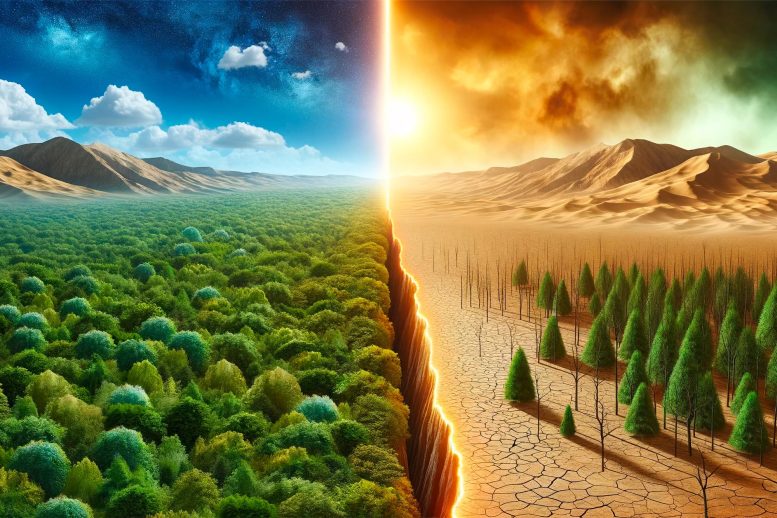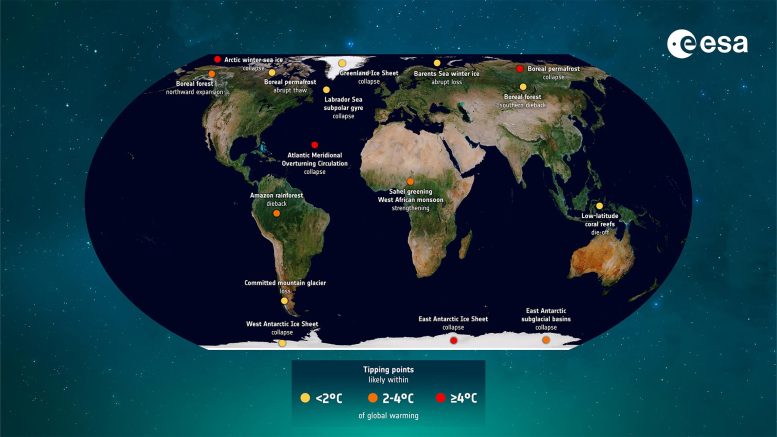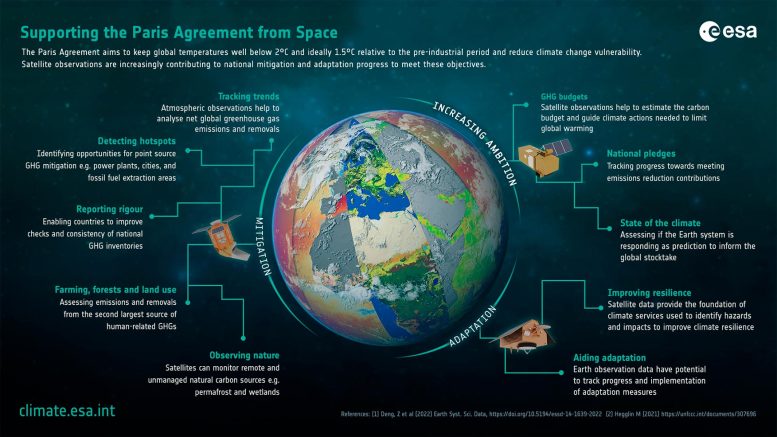
Climate tipping points are critical junctures in Earth’s environmental systems, where minor yet pivotal changes can lead to irreversible and dramatic shifts. These changes, ranging from melting ice caps to the demise of coral reefs, are direct consequences of global warming. The use of satellite technology is crucial in monitoring these tipping points, providing essential data for understanding and responding to these critical shifts in Earth’s climate systems. Credit: SciTechDaily.com
Climate tipping points mark pivotal moments in Earth’s climate system, where small alterations can result in irreversible and significant changes. The role of satellite observations is invaluable in tracking and comprehending these critical changes in the climate.
As the planet warms, many parts of the Earth system are undergoing large-scale changes. Ice sheets are shrinking, sea levels are rising and coral reefs are dying off.
While climate records are being continuously broken, the cumulative impact of these changes could also cause fundamental parts of the Earth system to change dramatically. These ‘tipping points’ of climate change are critical thresholds in that, if exceeded, can lead to irreversible consequences.
What Are Climate Tipping Points?
According to the Intergovernmental Panel on Climate Change (IPCC), tipping points are ‘critical thresholds in a system that, when exceeded, can lead to a significant change in the state of the system, often with an understanding that the change is irreversible.’
In essence, climate tipping points are elements of the Earth system in which small changes can kick off reinforcing loops that ‘tip’ a system from one stable state into a profoundly different state.
For example, a rise in global temperatures because of fossil fuel burning, further down the line, triggers a change like a rainforest becoming a dry savannah. This change is propelled by self-perpetuating feedback loops, even if what was driving the change in the system stops. The system – in this case the forest – may remain ‘tipped’ even if the temperature falls below the threshold again.
This shift from one state to the other may take decades or even centuries to find a new, stable state. But if tipping points are being crossed now, or within the next decade, their full impact might not become apparent for hundreds or thousands of years.
On top of that, the crossing of one tipping point could lead to the triggering of further tipping elements – unleashing a domino-effect chain reaction and could lead to some places becoming less suitable for sustaining human and natural systems.
For example: the Arctic is warming almost four times faster than anywhere else in the world, accelerating ice melt from the Greenland Ice Sheet (and the melting of Arctic sea ice).
This in turn could be what is slowing down the ocean’s circulation of heat, the Atlantic Meridional Overturning Circulation (AMOC), in turn impacting the monsoon system over South America. Monsoon changes may be contributing to the rising frequency of droughts over the Amazon rainforest, lowering its carbon storage capacity and intensifying climate warming.
The impacts of such a ‘tipping cascade,’ crossing multiple climate tipping points, could be more severe and widespread.
Climate Tipping Elements
In the early 2000s, a range of tipping elements were first identified and were thought that they would be reached in the event of a 4°C increase in global temperatures. Since then, science has advanced tremendously and there have been many studies on tipping-point behaviour and interactions among tipping-element systems.
These elements broadly fall into three categories — cryosphere, ocean-atmosphere, and biosphere — and range from the melting of the Greenland ice sheet to the death of coral reefs.
According to the newly-published Global Tipping Points Report, five major tipping systems are already at risk of crossing tipping points at the present level of global warming: the Greenland and West Antarctic ice sheets, permafrost regions, coral reef die-offs and the Labrador Sea and subpolar gyre circulation.
Click here for an interactive version of the infographic below to learn more about each climate tipping point.

Climate tipping points are specific thresholds within Earth’s complex systems, such as the atmosphere, oceans and ecosystems – where a change in the Earth’s climate can trigger an irreversible shift in the system’s state. These points mark areas where transition from one stable climate state to another are already taking place, often leading to cascading effects that impact ecosystems, weather patterns and global climate dynamics. Credit: ESA
What Can Satellites Reveal About Climate Tipping Points?
Our planet has already warmed by roughly 1.2°C since the Industrial Revolution and current pledges under the Paris Agreement put us on track to increase that to 2.5–2.9°C temperature rise this century. Recent assessments found that even exceeding 1.5°C of global warming risks crossing several of these thresholds for tipping points.
Earth observation plays a crucial role in monitoring and understanding climate tipping points by providing a comprehensive view of the Earth’s systems. Satellites orbiting our planet enable scientists to track changes in polar ice sheets, and their glaciers and ice shelves, deforestation rates, ocean temperatures and other key indicators.
For instance, satellites such as ESA’s CryoSat and Copernicus Sentinel-1 can measure changes in ice volume and flow. Satellites that provide information on gravity can work out how much ice is being lost in polar regions, helping to identify potential tipping points in ice sheet stability and the pace of their response to climate change.

The Paris Agreement aims to keep global temperatures well below 2°C and ideally 1.5°C relative to the pre-industrial period and reduce climate change vulnerability. Satellite observations are increasingly contributing to national mitigation and adaptation progress to meet these objectives. Credit: ESA
Optical satellites like Sentinel-2 contribute to monitoring changes in land cover or vegetation, such as the expansion or decline of critical ecosystems like the Amazon rainforest.
ESA’s Soil Moisture and Ocean Salinity (SMOS) satellite and the upcoming Fluorescence Explorer (FLEX) mission contribute to monitoring soil moisture and vegetation health. These missions can aid in understanding changes in terrestrial ecosystems and their resilience to climate impacts.
In the context of ocean circulation patterns, satellites like Sentinel-3 and SMOS contribute to monitoring sea surface temperatures, currents, ocean colour and sea surface salinity, providing insights into the strength and dynamics of the Atlantic Meridional Overturning Circulation.
By capturing a wide spectrum of data, satellites provide essential information for early detection of environmental shifts, enhancing our understanding of these complex phenomena and aiding in developing effective strategies for climate mitigation and adaptation.









It is questionable if such a thing as a ‘Tipping Point’ is real. If they were, then one would expect that long ago Earth would have entered into an extreme condition from which there was no escape, be it hot-house or ice-house. The fact that a changing climate is being discussed is evidence that we are not locked into an unchanging climate after 4.5 billion years of extremes. There is nothing happening today that hasn’t happened before. During the Eemian (Sangamonian Stage) Interglacial, bare ground was exposed in Greenland and it supported vegetation in areas that are today under more than a mile of ice; during the Paleocene-Eocene Thermal Maximum it was even hotter. Yet, an irreversible ‘Tipping Point’ was not triggered. The use of ‘Tipping Point’ is disingenuous because there is no evidence that ‘Tipping Points’ are even possible; it is conjecture. The intent is to scare people into accepting Draconian actions simply because there is supposedly no way to recover. It is like the irresponsible coining of the term “ocean acidification” to describe a slight reduction of basic sea water (0.1 pH units out of a possible 14.0 pH units), which has remained alkaline (pH>7) and probably always will be according to the well known geochemist Konrad Krauskopf of Stanford University, because of the (bi)carbonate and borate buffering chemical reactions.
As Sargent Joe Friday used to say, “Just the facts, Ma’am. Just the facts.” Please!
“Tipping” points are based on human assumptions.
You know what they say about when you ass-u-me.
Yes I know they use historical and recorded data but even with that the calculations and observations are still based on a human assumption of what/why/how.
Truth is we have little to no control over the climate and have no way of knowing what it will do 50 years in the future.
As usual, Spencer spews more stupidity and ignores historical accuracy while actually describing historical “tipping points”. Your ignorance to “facts” is astounding. Hey Clyde – most of us have just learned to totally ignore you.
Your fact-free personal attacks are not very compelling. You obviously disagree with me, but provide only your opinion as a response. If you were “totally” ignoring me, you wouldn’t be responding to me. Once again, you are not only spewing things you don’t support with citations, but you actually demonstrate that your claims are false. Just the facts, Ma’am. Just the facts!